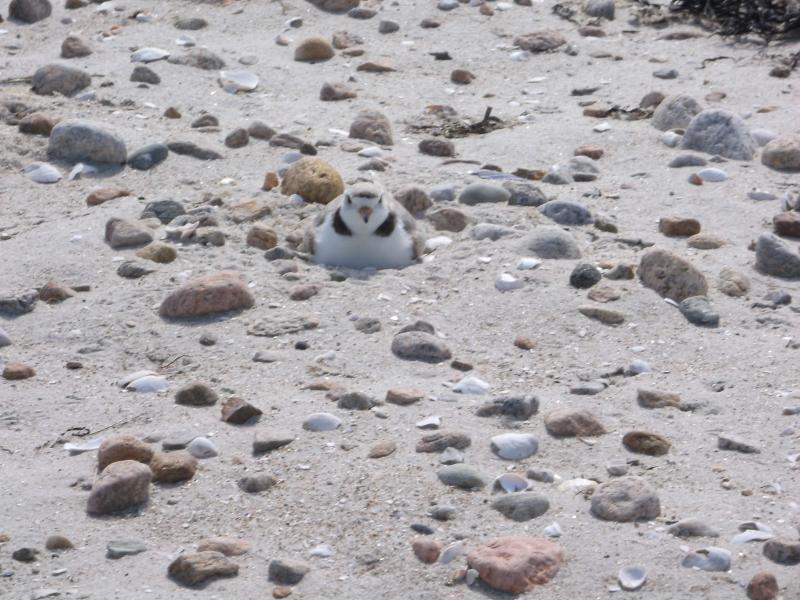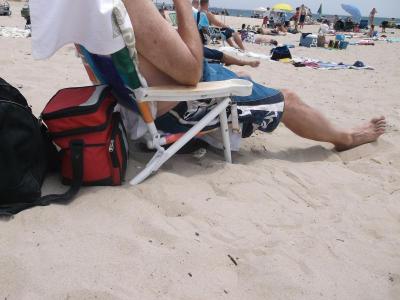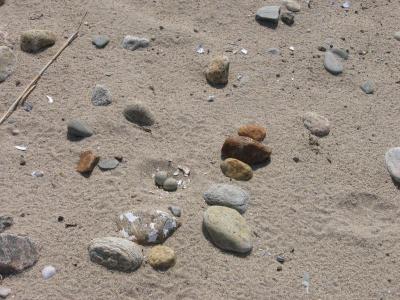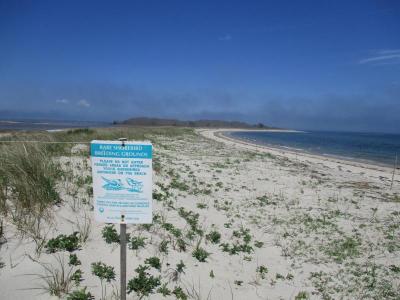Plovers From a Distance: Shorebirds and the Coronavirus Pandemic by Jamie Bogart, Lloyd Center Research Associate
As these days role on, we’ve become accustomed to adjusting our behaviors in a variety of ways, to accommodate the new social distancing strategy used to “flatten the curve” of COVID-19. If not reduced to solitary confinement, we’re steering clear of others around us. We’ve acquired a new threshold of disturbance and become outright territorial, some might say, just like a Piping Plover. For a plover, getting six feet from much of anything is more than disturbing. The plovers, no strangers to “quarantine”, are those brownish white birds on the upper beach which receive protection with fenced refuges to prevent disturbance of their nesting activity, due to their protection under federal and state law as an endangered species.
Piping Plovers and their eggs have cryptic coloration which allows them to blend into their habitat, an adaptation to avoid predation by a variety of wildlife. Nests may occur on an open sandy beach, far back in a dune system or even in a crack in a parking area. The most common habitat types in the Buzzards Bay region, which contains relatively small beaches and extensive rocky area in comparison to Cape Cod, are a tight mix of barrier beaches (Horseneck), barrier islands (Gooseberry, West Island) and sand spits (Allens Pond, DCR Demarest Lloyd State Park). The hatchlings (pic) are precocial, meaning they can walk immediately after hatching, and are therefore highly vulnerable. Fledges are hatchlings that have survived to flight stage and recruited into the breeding population, and resemble adult plovers without markings.
Piping Plovers (Charadrius melodus) are a shorebird that has always had to endure a harsh beach environment due primarily to storms and beach erosion, and natural predators which wreak havoc on both nests and hatchlings. Over time, our expansion across the coastal landscape with construction of infrastructure (piers, lots, etc.) to accommodate human use, has interrupted natural beach ebb and flow, both reducing natural habitat and attracting additional predators. This human element resulted in the endangerment status enacted in 1986 that continues today. Every April plover staff locate nesting pairs, install fenced refuges, and monitor bird territorial activity (scraping), to locate nests. We monitor the egg incubation period to determine hatching success, and for successful hatches, the fate of the hatchlings, each phase covering about a month. Along the way, staff note any cause of nest or chick mortality, which for eggs is usually predation and tidal or storm overwash, and for chicks disappearance due to predators. We note numbers of fledges which indicate productivity, or chicks fledged per pair, this being the critical statistic that determines how successful nesting was.
The threats to plovers and how we manage them have changed little over the past three decades. Over time however, the population has rebounded from just over 100 pairs to approximately 700 today in Massachusetts, which holds 15% of the world plover population (MassWildlife). This population increase has created new challenges and management approaches in the wake of unrelenting human use of beaches. Plover monitors are working more intensively than ever to ensure increasing numbers of birds have their space, while the state does its part in making regulatory adaptations such as “Habitat Conservation Plans” (HCP) (see MassWildlife website). This new conservation tool opens up beaches to recreation, thus potentially exposing some plover pairs to harm (“take”) from certain allowable human activities. These human activities are permitted if measures such as escorting vehicles through chick habitat to prevent hatchling mortality, or closely monitoring incubation on nests with reduced fencing buffers to prevent nest abandonment, are put in place. The birds continue to have the same endangered status, which will remain until a certain level of abundance and productivity is sustained over time, but are increasingly at conflict with human recreation. Management tools such as HCP’s depict where we are with plover management, ensuring the birds and people can coexist.
Which brings us to this season. Effective April 3, state beach parking areas were closed indefinitely and certain towns have followed suit, to avoid group gatherings that may cause the spread of COVID-19. The plovers are back, pairs busy scraping out territories, some already choosing the nest.
In early May the colonial Least Terns (as if mocking us with their colonial grouping behavior) will also return ready to cover some beaches with their nests. As access to beaches is all but eliminated, we shorebird protectors are reminded of past rainy springs when beaches were void of people and the birds took notice. Only now, rain or shine, the birds own the beach, and chances are that bird abundance will be high. People already are happy to see some fenced areas as a sign of “the way things were” but without a doubt, not everyone is a plover fan to begin with. Plover protectors are faced with an interesting conundrum as we prepare to “greet” a weary society which sees the beach as the great escape from COVID-19. In these surreal times, how do we explain the beauty of “Keep Out”?
A major part of our duties, in addition to monitoring human use to help prevent disturbance to plovers, is educating the public, which includes explaining the significance of the species. Plovers, and on some beaches Least Terns, are the only birds nesting out on open sand. These are therefore “indicator species”, meaning their presence is indicative of a habitat type, in this case barrier beaches, a rare and sensitive habitat. Barrier beaches, including dune areas, are protected under the Massachusetts Wetland Protection Act, and much like the birds that use them, are protected by laws from destruction. Because we are permitted to recreate on them, the presence of plovers is a good thing, a sign of a healthy beach. A declining plover population points to declining beach habitat (e.g. increasingly rocky), or worse, one that’s washing away. One can see growth of natural vegetation within our fencing, and picture what the entire beach would look like if left untrammeled.
Going back to the social distance commanded by the plover community and provided by our fencing, remember again that the birds remain protected from any disturbance by law. Yet more than ever we are managing for both plovers and people and actually striving to secure only the minimum area necessary to prevent human-induced nest abandonment or hatchling mortality. This accommodates the human recreational side while not disrupting the shorebird breeding cycle. We also always hope for early hatches on first attempts, so broods of hatchlings are strong going into the July 4th weekend. However, certain factors independent of amount of area provided, such as predation and storm overwash, make the perfect season a rare event, with eggs sometimes hatching as late as August.
So knowing the value of the birds and the fact that they are protected, what can a beachgoer do? Spend some time watching the behaviors of the birds to witness fascinating behavior, whether its courtship displays, territorial disputes, or movements of the tiny hatchlings that resemble cotton balls on stilts. Plover stewards are there to answer any questions you may have. There are also things that beachgoers can do to become vested in the effort and help our cause. These are to respect fenced refuges, don’t approach the birds closely, don’t leave trash behind which may attract predators at night, and prevent your dog from entering refuges or chasing birds (a take under law). These small steps help ensure the Piping Plover stays on the road to recovery in this changing world.
Piping Plovers face the constant stresses of adverse weather, hungry predators, and recreation, not to mention the growing threats of climate change and sea level rise. This season, we have a public health crisis, the Coronavirus Pandemic that has the public all but immobilized and waiting to burst out onto their favorite beach that is starting to resemble an oasis. At this stage we can’t project what the status of COVID-19 and social distancing will be when the hot weather arrives, but people are eyeing the beaches as intensively as the birds that nest on them. It’s also reasonable to think (that possibly) the beaches will indeed be open for summer, at least in some capacity. Will people be like plovers, quiet and widely spaced across the sand, or a large, eager flock of terns ready to take over the beach? This remains to be seen as we trudge through these trying times and fight through “quarantine”. Whatever unfolds, rest assured that the plover stewards, fences, and birds, will be out there waiting.


















